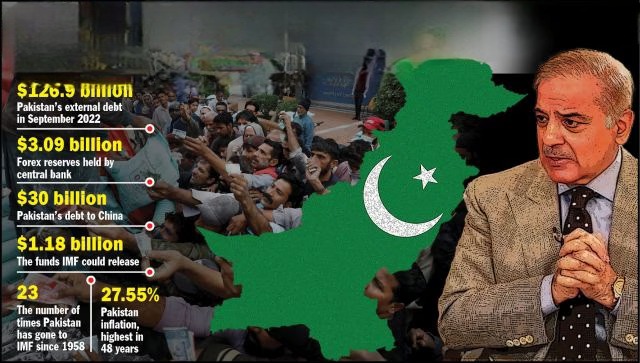Pakistan gets final IMF nod for $3-bn loan in stand-by arrangement
Context:
The International Monetary Fund (IMF) approved a $3 billion “stand-by arrangement” for Pakistan on Wednesday, providing financial respite to the country’s cash-strapped government by supporting its attempts to stabilize the struggling economy.
What is IMF and IMF Bailout?
- Establishment and Goals:
-
-
- To restore the global monetary system following World War II, the International Monetary Fund (IMF) was founded in 1944 at the Bretton Woods Conference.
- It officially began on December 27, 1945, with 29 member nations and the objective of advancing world financial stability.
-
- Membership and Organization:
-
-
- The 190 nations that make up the IMF almost entirely represent the world’s population.
- Each member nation picks a governor to represent its interests when the IMF makes decisions.
- The IMF’s Board of Governors, which consists of representatives from all of its members, is the organization’s highest decision-making body. It holds a yearly meeting.
-
- Mission Statement and Goals:
-
-
- The main goals of the IMF are to promote international monetary cooperation and ensure global financial stability.
- Its goals include fostering high employment, achieving sustainable economic growth, and eradicating poverty on a global scale.
- The IMF wants to give its members a forum for cooperation and multilateral economic problem-solving.
-
- monetary resources
-
-
- Based on their economic size and other considerations, member nations are allotted a certain amount of money to contribute to the IMF’s resource pool.
- Each country’s voting power and the amount of IMF funding they are eligible for are determined by quotas.
- The loan and investment activities of the IMF also bring in money.
-
- Last-Resort Lender:
-
-
- The IMF is frequently referred to as the world’s last resort lender.
- It offers financial support to member nations experiencing severe economic crises or balance of payments issues.
- This aid, which frequently takes the form of loans, attempts to assist nations in stabilizing their economies, carrying out crucial reforms, and resuming growth.
-
- Policy Advice and Monitoring:
-
- To encourage prudent economic policies and financial stability among its member countries, the IMF conducts surveillance and provides policy advice.
- It evaluates the economic and financial conditions of nations, makes suggestions, and keeps track of how well policy initiatives are being carried out.
- Risks, imbalances, and vulnerabilities in national and international economies are uncovered via IMF surveillance.
IMF Bailouts
- Bailouts are financial aid given to a firm or nation that is in financial trouble or at risk of bankruptcy.
- They may take the shape of loans, cash infusions, bond acquisitions, or stock purchases, among others.
- (IMF) is a global institution that offers financial support and assistance to nations that are exposed to serious macroeconomic risks.
- When nations face significant economic difficulties like currency crises, heavy foreign debt loads, or balance of payment issues, they frequently turn to the IMF for assistance.
- IMF bailouts primarily aim to assist nations in meeting their responsibilities under their foreign debt, stabilize their economies, and correct fundamental imbalances.
- The country may get financial assistance from the IMF in the form of loans, credit lines, or financial aid to help it pay for imports of vital goods, support its currency, and improve its overall economic condition.
- Conditions and demands are attached to IMF bailouts that the receiving nation must meet. To address the underlying reasons of the financial troubles, these circumstances frequently entail enacting economic reforms, budgetary restraint, austerity measures, and structural adjustments.
What are the conditions asked by the IMF?
- IMF loan recipients may be required to commit to the implementation of specific structural changes.
- These requirements have drawn criticism for being too onerous on the populace, being influenced by world politics, and being viewed as excessively interventionist by proponents of the free market.
- The Special Drawing Rights (SDRs) that the IMF lends to struggling economies typically reflect a basket of five different currencies.
- Various programs, including stand-by agreements, flexible credit lines, and extended credit facilities, are used to carry out the lending.
- Depending on their unique circumstances, the bailout countries may use the SDRs for a variety of purposes.
What are the advantages of IMF Bailouts?
- Bailouts guarantee a nation’s existence during challenging economic times by addressing balance of payments (BoP) issues without turning to more drastic measures.
- They aid in preventing a total financial system collapse, particularly when major industries that are too big to fail encounter considerable difficulties.
- Bailouts can keep institutions from going bankrupt, which is crucial for the efficient operation of the market as a whole.
- The IMF can offer governments technical assistance and expertise in addition to financial support to improve institutions and achieve economic reforms.
What are negative impacts it can cause while depending on IMF bailouts?
- The severe requirements set forth by the IMF for economic policy reforms may result in lower public spending, higher taxes, and other potentially divisive policies that could spark societal upheaval.
- It may be more difficult to access international capital markets if a country has a bad image with investors and lenders as a result of seeking an IMF bailout.
- Repeated IMF bailouts may make a country feel dependent on outside money and deter it from making the long-term reforms that are required to solve its economic difficulties.
- IMF bailouts may be interpreted as a government’s acknowledgment of economic failure, which could cause political instability or possibly the government’s collapse.
How much Bailout is Pakistan getting from IMF?
- clearance and Amount: Pakistan has received final clearance from the International Monetary Fund (IMF) for a $3 billion “stand-by arrangement” to help its efforts to stabilize the economy.
- Payment: Pakistan may now immediately receive $1.2 billion thanks to the IMF’s clearance. Subject to two quarterly evaluations, the remaining cash will be paid out gradually throughout the course of the program’s nine-month runtime.
- Program’s primary goal: The implementation of Pakistan’s FY24 budget will be the main focus of the IMF program. By facilitating budgetary adjustment, its approach intends to address the nation’s economic problems and ensure long-term debt sustainability.
- Money from West Asia: Pakistan received financial assistance from West Asian nations before obtaining the IMF loan. United Arab Emirates gave $1 billion, while Saudi Arabia contributed $2 billion. These monies were probably acquired under particular restrictions imposed by the IMF.




